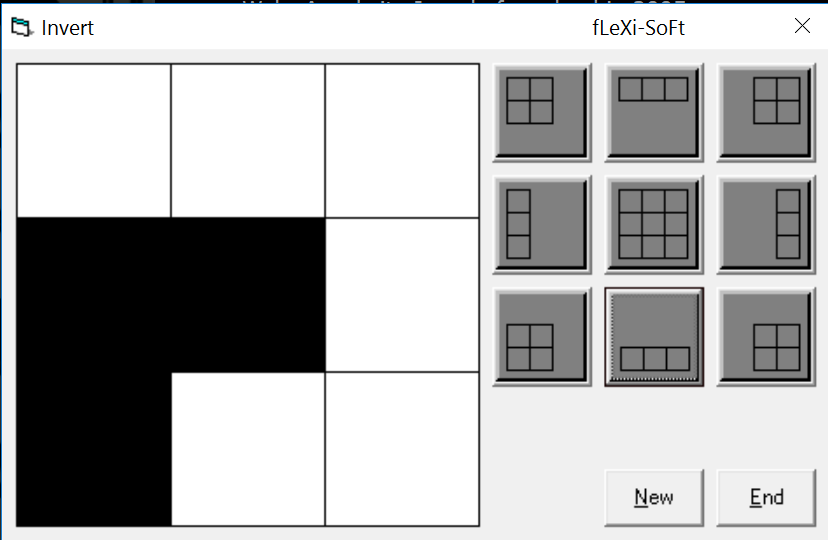We (Noodlecake) first saw Invert back at GDC 2015 after meeting with Glitchnap’s Jonas, Joon and Mads about porting their game Try Harder to Android. Joon had this prototype of a game they were working on called Invert and even on the initial pitch, I could tell there was a storied history behind it. There was a tone to Jonas’s voice that it had been a bit of a struggle to say the least.
Before I dive into the story behind it, here is a quick rundown of the game. In Invert, you are given a grid of tiles in various shapes and patterns and the goal is to flip all the tiles to be either all white or the same color. Along the edges of the grid there are buttons that correspond to a particular shape on the grid. By selecting that button, all the tiles will flip or “invert” from color to white, or white to color. So for example, one button might be activate an entire row, another might just do a block or an angle. Each level pack has a more complex set of patterns and shapes to deal with.
Invert contains over 20 hand crafted levels with 1000’s of combinations and three different game modes.
– Campaign: Solve preset levels in a certain amount of moves. Take as much time as you need.
– Challenge: Solve levels against the clock. Use as many moves as you want. The faster you solve the patterns, the better your rating. Speed runners will take a liking to this one.
– Expert: Similar to Challenge Mode, but a lot harder. Like, a *lot* harder.
To kick off the story here is a quote from the Glitchnap team:
“We developed Invert as a simple prototype with a 5 x 5 pattern as part of different project. Joon had the original inspiration for it from Rubick’s Cubes and had actually already made a prototype of Invert as a teenager back in 2002 (made in Visual Basic 4, windows 95).” Check out the amazing screen grab below of the Visual Basic game.

Right from the start, Invert was unlike anything Glitchnap had made in the past. As a studio they always had a focus on social and physical play (example Sentree) with their games, but they took it on as a challenge to find a puzzle game that was actually interesting to them. Initially all the levels were 5×5 grids with different special buttons, but Mads and Joon soon realized that the underlying mathematical principals would allow them not to be confined to neat grids. Instead they could apply the same principals to other layouts like triangles, hexes and more.
But during this time there was dissension in the ranks. Mads and Joon were fully on board but Jonas was still having a hard time “clicking” with the game. However one night after playing it 3 hours straight, he went to bed and his brain kept visualizing and “solving” levels of the game in his head. Just like that, he became fully invested and I can speak from my own experience playing the game that this does happen. There is a moment where you go from just randomly flipping tiles to suddenly “seeing the matrix” and the puzzles that seemed impossible now just fall into place.
By 2016, the team was happy with the core mechanics of the game but were struggling with the overall gameplay system and hit a wall. Frustrated and stuck, Mads and Jonas went to Iceland to see Joon and discuss the future of the game (internally dubbed “The Pretentious Puzzle Game Summit”). In between nature treks and hot spring skinny dipping they tried to define what the core draw of the game was: Casual couch play, hardcore logic puzzle or interesting visual experimentation? Unable to crack the gameplay system they put the game on hold to get some distance from the project and hopefully come back with a clear head. In 2017 they revisited the project and talked with Asher Vollmer (creator of Threes!), Martin Jonasson (Grapefrukt) and Ste Curran (game designer, writer and speaker) for advice and inspiration.
“We brought in an external game designer to consult with us on the project and realised the game could work as both a hard logic challenge and a more freeform toy-like thing to fiddle with. This is where the three different game modes – Campaign, Challenge and Expert came into being along with a vastly improved tutorial. ”
“We play tested the game with a bunch of people in our network, refined it and bring it to GDC in March 2017. Here we show it to anyone and everyone to get a read on whether the the different game modes and improved tutorial worked as we had hoped. Luckily the game seems to click with a lot of different people. There was actually a pretentious puzzle game meetup in the hallway at GDC with Asher, Martin and us. ”
Working with a team like Glitchnap really encapsulates what we love about being an indie publisher. We get a chance to work with some super talented developers who not only make great games, but have become great friends to us as well.
Check out the game over on its official page and enjoy!